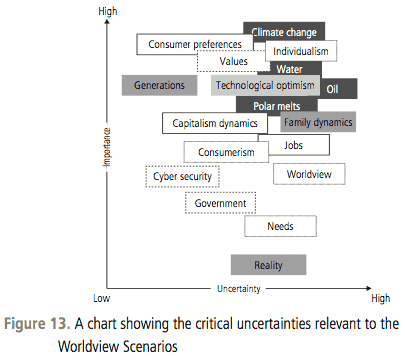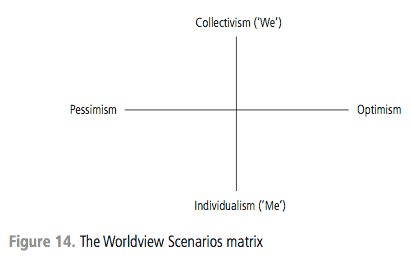
11
Building Scenario Worlds:
the third stage
Now we are finally ready to build our scenario worlds. This stage involves convergence. We take the fruits of our brainstorming about the external environment and mould them into several scenarios. There are two main process that we can use to do this, but whichever process we use, this stage is not about prediction or probability. It’s about imagining alternative futures that are plausible, robust, and challenging. We also need to ensure that we have created very different futures, from the utopian to the dystopian, and from the incremental to the radical.
Narrowing the Influences
We started by narrowing down the 300 or so influences that we identified in Chapter 10 as having the potential to change the world. We’re not going to drown you with an initial list of all 300 influences — we’ll skip ahead to a shorter, refined list. We used the (I)NSPECT categories once more to both simplify and expand on our brainstorming, and to identify the relevant influences. The following table is the result. Next to each influence we have also given details of the uncertainty that we want to examine.
The Worldview Scenarios Influence Table
|
INFLUENCE |
WHAT WE WANT TO EXAMINE |
|
Nature |
|
|
Climate change and the weather |
Level of volatility |
|
Polar ice-caps |
Rate of melting |
|
Fresh water |
Availability, price, and quality |
|
Oil and other natural resources |
Scarcity and price |
|
Pandemics |
Incidence |
|
Natural disasters |
Impact of local events on global systems |
|
Society |
|
|
Neurology |
Impact of technology on |
|
Reality |
Physical versus virtual |
|
Ageing |
Impact on the economy and households |
|
Fertility |
Impact on labour supply |
|
Urbanisation |
Ubiquity and rate of growth |
|
Households |
Dynamics of living spaces |
|
Family life |
Nature (e.g. fragmented, nuclear, cohesive) |
|
Generational change |
Impact on the economy and society |
|
Multiculturalism |
Impact on society |
|
Traditional media |
Top-down versus bottom-up |
|
Social media |
Active versus passive |
|
Attention spans |
Level |
|
Surveillance |
Level |
|
Measures of progress |
Economic versus humanitarian |
|
Politics |
|
|
Cyber security |
Level of risk |
|
Media |
Impact |
|
Government |
Big versus small |
|
Governance |
Top-down versus bottom-up |
|
Taxation |
Level |
|
Regulatory framework |
Level (e.g. low/restorative/high) |
|
Infrastructure |
Public versus private provision |
|
Values |
Conservative versus liberal |
|
Green politics |
Level |
|
Global trade |
Free versus protectionist |
|
Representative democracy |
Relevance |
|
Globalisation |
Global versus local focus |
|
Warfare |
Tech-based versus physical |
|
Economics |
|
|
Consumer preferences |
Price versus value |
|
Innovation |
Level |
|
Crowdsourcing |
Level |
|
Crowdfunding |
Level |
|
Economic growth |
Long boom versus collapse |
|
The economy |
Free market versus mixed and ethical |
|
Jobs |
Availability and type |
|
The creative economy |
Size |
|
Money |
Equitability, physical versus digital |
|
Brand loyalty |
Level |
|
BRICs |
Power base |
|
PIIIGS |
Economic health |
|
Capitalism 1 |
Autocratic versus free market |
|
Capitalism 2 |
Individualistic versus communitarian |
|
Capitalism 3 |
Ascendant versus in decline |
|
Culture |
|
|
Popular culture |
Dynamics of participation |
|
Individualism |
Me versus we |
|
Worldview |
Global versus local |
|
Consumerism |
Active versus passive |
|
US culture |
Global dominance of |
|
Literacy |
Text-based versus visual |
|
Spirituality |
Growth |
|
Privacy |
Level |
|
Leisure pursuits |
Pleasure versus improvement |
|
Maslow’s hierarchy of needs |
Survival and utility versus status and fun |
|
Technology |
|
|
Internet 1 |
Dependability |
|
Internet 2 |
Level of neutrality |
|
Internet 3 |
Access |
|
Mobile |
Level of convergence |
|
Landline telephones |
Amount |
|
Cloud computing |
Global versus local control |
|
Optimism regarding technology |
Level |
|
Biotechnology |
Organic versus radical |
|
Technology pushback |
Level of ‘must have’ |
|
Nanotechnology |
Impact |
Our next task was to sort the list by ranking each of them by importance and level of uncertainty.
Before we did so, we once again reminded ourselves of the framing questions against which this sorting needs to be done: What opportunities and challenges might we face in 2040, in terms of lifestyles that are socially, culturally, and ecologically desirable? What can we do to influence the future as it might unfold to promote more resilient and successful ways of living?
Figure 12 shows how we charted the key influences, the critical uncertainties. In charting them, we could see the environmental conditions that are more likely to shape the relevant alternative futures out to 2040.

Creating a Scenario Matrix
Remember the critical uncertainties we discussed in Chapter 8? When we used them in relation to the Worldview Scenarios, we created an impax chart, shown in Figure 13.

We then created a series of matrices by selecting any pair of impaxes that we believed would be significant shapers of the future. We chose impaxes that were quite dissimilar to ensure that the relationship between the two was orthogonal — that is, that each was qualitatively different from the other.
After several days of play, we settled on the pair in Figure 14: individualism versus collectivism (the prevailing level of emphasis on ‘me’ at one end of the continuum, and on ‘we’ or ‘us’ at the other), and whether society as a whole felt optimistic or pessimistic about the present and the future (optimism, primarily about climate change and economic prospects, at one end, and pessimism at the other). We also considered many other drivers — for example, societal attitudes towards technology — but we felt that while they were uncertain, they did not carry quite the level of impact or uncertainty provided by either climate change or the economy.

We choose this pair as a starting point because we know that we don’t live in a two-variable world — however enamoured you may be of the two-speed economy!
Then we enriched each world by going back to the larger group of impaxes and introducing each instrument, rather in the manner of Peter and the Wolf, until we had a veritable orchestra to create the music of our Worldview Scenarios.
It’s important to name each of the four quadrants, or scenarios, represented on the matrix. After much discussion, we settled upon the following four names.

This matrix was the foundation upon which the Worldview Scenarios stories were built. But before we wrote the stories, we had to enrich the worlds, imagining that we were living in each of them and ensuring that there were more than two characteristics to give each future its individual sex, colour, and movement. We have summarised our thinking about what it would be like to live in each of these futures in the table of scenario characteristics that follow.
Armed with our matrix and the table, we were able to write the narratives to bring our worlds to life.
IMAGINE
Society
Economy
Environment
Politics
Regulation
Technology
Personal relationships
Work
Leisure activities
Spending patterns and currencies
Key needs
Dominant or admired companies and organisations
Epitomised by
In a word
PLEASE PLEASE ME
Society
Economy
Environment
Politics
Regulation
Technology
Personal relationships
Work
Leisure activities
Spending patterns and currencies
Key needs
Dominant or admired companies and organisations
Epitomised by
In a word
DEAR PRUDENCE
Society
Economy
Environment
Politics
Regulation
Technology
Personal relationships
Work
Leisure activities
Spending patterns and currencies
Key needs
Dominant or admired companies and organisations
Epitomised by
In a word
HELTER SKELTER
Society
Economy
Environment
Politics
Regulation
Technology
Personal relationships
Work
Leisure activities
Spending patterns and currencies
Key needs
Dominant or admired companies and organisations
Epitomised by
In a word